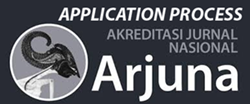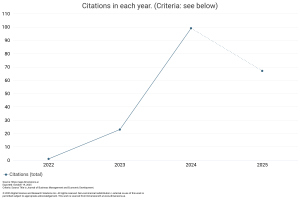Monetary Policy Dynamics and the Nigeria’s Global Competitiveness: The Missing Link
DOI:
https://doi.org/10.59653/jbmed.v2i02.717Keywords:
Monetary Policy, Dynamics Nigeria’s Global Competitiveness, Missing LinksAbstract
Despite the series of monetary policies adopted by the Nigerian government over time, the (Nigerian) economy in comparison to other countries in the world like South Africa, the USA, Ghana, and the like is still improvised. Still, inconsistency between monetary policy formulation and implementation remains another major issues yet unattended to. It is in this regards that, the current study is dedicated towards examining the effect of monetary policy dynamics and the Nigeria’s global competitiveness from 1992 to 2021 (i.e., 30 years) using Autoregressive Distributed Lag (ARDL) model. The study disclosed that, the variables are integrated at level and first difference while the ARDL Bound test evidenced that, the series cointegrates. Specifically, monetary policy rate has a positive minimal effect on Nigeria’s global competitiveness, while the CRR improved Nigeria’s global competitiveness significantly. However, both lending rates and exchange rates have a significant negative effect on economic competitiveness. Consequently, the paper concludes that both the cash reserve ratio and the Nigeria’s demeaning state are attributed to the high exchange rate (EXR) and high lending rates. Thus, the paper submits that the current monetary policy rates are sustained and that all DMBS should adhere to the stipulated Cash Reserve Ratio (CRR) since it has improved the Nigeria’s global competitiveness significantly. Lastly, the study confirmed that, the missing link is the policy surmount on the part of the Nigerian government.
Downloads
References
Adeagbo, M. O. (2021). Monetary policy and economic growth nexus in Nigeria. Ianna Journal of Interdisciplinary Studies, 3(2), 92-103. https://doi.org/10.1108/JAOC-11-2017-0109
Akinyede O.M. & Elumah, L.O. (2017). Economic policy and economic stability in Nigeria. Eurasian Review of Business and Finance, 1(1), 1-9. https://www.researchgate.net/profile/Akinyede-Oyinlola/publication/329255270_Financial_Deepening_and_Market_Stability_in-Nigeria/links/5d1d959ca6fdcc2462bdd28f/Financial-Deepening-and-Market-Stability-in-Nigeria.pdf
Alasha, R.U. (2020). The impact of exchange rate fluctuations on economic growth in Nigeria. Unpublished B.Sc. Project Work Submitted to the Department of Economics, Faculty of Management and Social Sciences Baze University, Abuja.
Alasha, R.U. (2020). The impact of exchange rate fluctuations on economic growth in Nigeria. Unpublished B.Sc. Project Work Submitted to the Department of Economics, Faculty of Management and Social Sciences Baze University, Abuja. https://www.proquest.com/openview/283643ac8bd8496902afc6e78e96b0b6/1?pq-origsite=gscholar&cbl=2026366&diss=y.
Amiri, A. G., & Gang, Z. (2018). The impact of monetary policy on economic growth in America's economy using a new approach tvp-favar. Amazonia investiga, 7(15), 58-68.
Anifowose, A.D. (2021). Economic growth and exchange rate dynamics in Nigeria. Imo State University /Business & Finance Journal 12 (1), 36-47. https://gojournals.gouni.edu.ng/index.php/gounijmss/article/view/57/
Anowor, O. F. & Nwanji, M. O. & (2018), Are There Nexus Between Public Expenditures and Economic Growth in Nigeria? - A Re-Examination. International Journal of Applied Economics, Finance and Accounting, 2(2), 40-46. http://eprints.gouni.edu.ng/1233/
Ayodeji, A. & Oluwole, A. (2018). Impact of Monetary Policy on Economic Growth in Nigeria. Open Access Library Journal, 5(2), 23-56. https://doi.org/10.4236/oalib.1104320
CBN (2017). CBN Statistical Bulletin, (online copy). Vol. 28 December 2017. Retrieved on 15 August, 2018, from: http://www.cenbank.org/OUT/2018/PUBLICATIONS/STATISTICALBULLETINS/2017/INDEX.HTML
CBN (2017). CBN Statistical Bulletin, (online copy). Vol. 28 December 2017. Retrieved on 15 August, 2018, from: http://www.cenbank.org/OUT/2018/PUBLICATIONS/STATISTICALBULLETINS/2017/INDEX.HTML
Central Bank of Nigeria (2017). Annual Report. Nigeria: Abuja
Central Bank of Nigeria (2017). Annual Report. Nigeria: Abuja
Central Bank of Nigeria (2018). Annual Report. Nigeria: Abuja
Central Bank of Nigeria (2018). Annual Report. Nigeria: Abuja
Chowdhury, L. A. M., Rana, T., Akter, M., & Hoque, M. (2018). Impact of intellectual capital on financial performance: evidence from the Bangladeshi textile sector. Journal of Accounting & Organizational Change, 14(4), 429-454.
Egbulonu, K. G. Ukwuoma, C.C. (2018). Impact of monetary policy on the growth of the Nigerian manufacturing sector (1980-2016). International Journal of Scientific & Engineering Research, 9(9), 1888- 1900. https://scholar.google.com/scholar?hl=en&as_sdt=0%2C5&q=Egbulonu%2C+K.+G.+Ukwuoma%2C+C.C.+%282018%29+Impact+of-monetary+policy+on+the+growth+of+the+Nigerian+manufacturing+sector+%281980-2016%29+International+Journal+of+Scientific+%26+Engineering+Research%2C-9%289%29%2C+1888+1900+&btnG=
Eko, E.O. Ehigocho, P.O. & Okoiarikpo, B.O. (2017). Monetary Policy Shocks and Industrial Output in Nigeria. British Journal of Economics, Management & Trade, 16(2), 1-13
Ezeaku, H. C., Ibe, I. G., Ugwuanyi, U. B., Modebe, N. J. & Agbaeze, E. K. (2018). Monetary policy transmission and industrial sector growth: Empirical evidence from Nigeria. SAGE Open, April-June, 1–12. https://doi.org/10.1177/2158244018769369
Havi, E. D. K., & Enu, P. (2018). The effect of money supply and monetary policy on Ghana’s Economic growth: Which policy is more potent? International Journal of Empirical Finance, 3(2), 61-75.
Ighosewe, E. F. (2022). Accounting Information and Value Relevance: A Quinquennial Comparison of Pre-and Post-IFRS Adoption of Listed Firms in Nigeria and South Africa. Modern Economy, 13(7), 1006-1023. . https://doi.org/10.4236/me.2022.137053
Islam, M. S., Hossain, M. E., Chakrobortty, S., & Ema, N. S. (2021). Does the monetary policy have any short-run and long-run effect on economic growth? A developing and a developed country perspective. Asian Journal of Economics and Banking, 6(1), 26-49. https://doi.org/10.1108/AJEB-02-2021-0014
Long, V. Ignatius, A. & Yang, F. (2019). The impacts of exchange rate on economic growth in Cambodia. International Journal of Applied Economics, Finance and Accounting, 2(1), 78-83. https://doi.org/10.33094/8.2017.2019.52.78.8
Long, V. Ignatius, A. & Yang, F. (2019). The impacts of exchange rate on economic growth in Cambodia. International Journal of Applied Economics, Finance and Accounting, 2(1), 78-83. https://doi.org/10.33094/8.2017.2019.52.78.83
Morina, F. Hysa, F. Ergün, U., Panait, M. & Voica, M.C. (2020). The effect of exchange rate volatility on economic growth: case of the CEE countries. Journal of Risk Financial Management, 13(177), 1-13. https://doi.org/10.3390/jrfm13080177
Mugableh, M. I. (2019). Does monetary policy affect economic growth in Jordan? Evidence from ordinary least square models. International Business Research, 12(1), 27-34. https://doi.org/10.5539/ibr.v12n1p27
Nwoko, Nnenna, M. Ihemeje, J. C. & Anumadu, E. (2016). The impact of monetary policy on the economic growth of Nigeria. African Research Review, 10(46), 193-206. http://dx.doi.org/10.4314/afrrev.v10i3.13
Okanyal, C.O. & Paseda, O. (2019). The central bank of Nigeria: history, current operations and future outlook. international journal of academic accounting, finance & management research, 3(1), 23-43. https://philpapers.org/rec/OKATCB.
Onakoya, A. B., Ogundajo, G. O. & Babatunde, S. J. (2017). Monetary policy and the sustainability of the manufacturing sector in Nigeria. Review of Innovation and Competitiveness, 3(4), 71 – 88. https://doi.org/10.32728/ric.2018.34/4
Onoh, J. O., & Nwachukwu, T. (2017). Monetary policy and credit delivery in commercial banks–Evidence from Nigeria. International Journal of Social Sciences and Management Research, 3(7), 2545-5303. https://iiardjournals.org/get/IJSSMR/VOL.%203%20NO.%207%202017/Monetary%20Policy.pdf.
Osakwe, A. Ibenta, S. N. ., & Ezeabasili, V. N. (2019). Monetary Policy and the Performance of the Manufacturing Sector in Nigeria (1986-2017). International Journal of Academic Research in Business and Social Sciences, 9(2), 399–413.
Osakwe, A. Ibenta, S. N. ., & Ezeabasili, V. N. (2019). Monetary Policy and the Performance of the Manufacturing Sector in Nigeria (1986-2017). International Journal of Academic Research in Business and Social Sciences, 9(2), 399–413. : http://dx.doi.org/10.6007/IJARBSS/v9-i2/5553.
Ozili, P. K., Oladipo, O., & Iorember, P. T. (2023). Effect of abnormal increase in credit supply on economic growth in Nigeria. African Journal of Economic and Management Studies, Vol. ahead-of-print No. ahead-of-print. https://doi.org/10.1108/AJEMS-02-2022-0036
Rahman, M. N., Nower, N., Tushar, R. H., Abbas, S. M., & Musa, M. N. (2019). Impact of monetary policy on the economic growth of a developing country: an empirical study on Bangladesh economy. http://dx.doi.org/10.2139/ssrn.3391280.
Teryoshin, Y. (2023). Historical performance of rule-like monetary policy. Journal of International Money and Finance, 130, 102766. https://doi.org/10.1016/j.jimonfin.2022.102766
Viphindrartin, S., Saleh, M., & Prestianawati, S. A. (2020). Effectiveness of the Monetary Transmission Mechanism in Achieving the Ultimate Goals of ASEAN-3. In 23rd Asian Forum of Business Education (AFBE 2019). Atlantis Press, 452-458. https://doi.org/10.2991/aebmr.k.200606.077
Wang, Y., Wang, X., Zhang, Z., Cui, Z., & Zhang, Y. (2023). Role of fiscal and monetary policies for economic recovery in China. Economic Analysis and Policy, 77, 51-63. https://doi.org/10.1016/j.eap.2022.10.011
Downloads
Published
How to Cite
Issue
Section
License
Copyright (c) 2024 Oghenekparobo Ernest Agbogun, Omolegie Bruno Oshiobugie, Oghenero Godday Oboro

This work is licensed under a Creative Commons Attribution-ShareAlike 4.0 International License.
Authors who publish with this journal agree to the following terms:
- Authors retain copyright and grant the journal right of first publication with the work simultaneously licensed under a Creative Commons Attribution-ShareAlike that allows others to share the work with an acknowledgement of the work's authorship and initial publication in this journal.
- Authors are able to enter into separate, additional contractual arrangements for the non-exclusive distribution of the journal's published version of the work (e.g., post it to an institutional repository or publish it in a book), with an acknowledgement of its initial publication in this journal.
- Authors are permitted and encouraged to post their work online (e.g., in institutional repositories or on their website) prior to and during the submission process, as it can lead to productive exchanges, as well as earlier and greater citation of published work (See The Effect of Open Access).





























